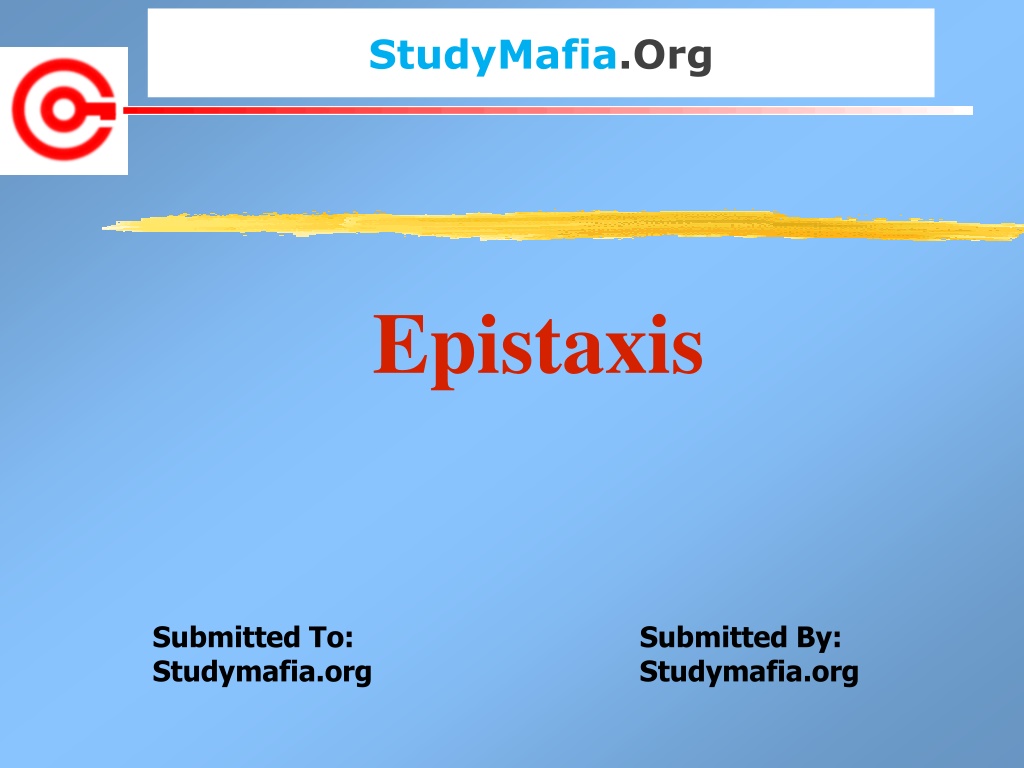Understanding Epistaxis: Causes, Symptoms, and Treatment
Epistaxis, or nosebleed, is a common condition with various causes such as trauma, tumors, and nasal sprays. It can be anterior or posterior, with different symptoms and treatments. Learn more about prevention strategies and complications in this comprehensive guide.
Download Presentation

Please find below an Image/Link to download the presentation.
The content on the website is provided AS IS for your information and personal use only. It may not be sold, licensed, or shared on other websites without obtaining consent from the author. Download presentation by click this link. If you encounter any issues during the download, it is possible that the publisher has removed the file from their server.
E N D
Presentation Transcript
StudyMafia.Org Epistaxis Submitted To: Submitted By: Studymafia.org Studymafia.org
Table Contents Definition Introduction Symptoms of Epistaxis Types of Epistaxis Causes of Epistaxis Complications of Epistaxis Prevention of Epistaxis Treatment of Epistaxis Conclusion 2
Definition Epistaxis (eh puh stak suhs) comes from the Greek word epistazein which means "bleed from the nose" and is a combination of the two words: epi meaning "upon, in addition" and stazein meaning "to drip". 3
Introduction Epistaxis (also called a nosebleed) refers to a minor bleeding from the blood vessels of the nose. Epistaxis is a commonly-found complaint, especially in fields of emergency medicine related to the treatment of ear, nose, and throat (ENT) conditions. Epistaxis more commonly occurs in children (ages 2 10) and older adults (ages 50 80). There are two types of epistaxis depending on their origin: anterior and posterior epistaxis. 4
Types of Epistaxis Anterior epistaxis refers to a nosebleed that originates from the anterior (frontal) part of the nose. Anterior epistaxis is the most common type of nosebleed, and usually involves one nostril. 6
Types of Epistaxis Posterior epistaxis refers to bleeding from the posterior or superior nasal cavity. Posterior epistaxis usually involves both nostrils. For these types of nosebleeds, the blood may also flow backwards and uncomfortably get swallowed or coughed up (hemoptysis). 7
Causes of Epistaxis Local causes Local causes of epistaxis can include local trauma caused by nose-picking, a foreign body in the nose, anatomic irregularities such as a deviated septum, facial trauma, incorrect or excessive use of topical nasal sprays, inflammatory reactions, and rarely intranasal tumors. 8
Causes of Epistaxis Systemic causes Some systemic conditions that increase the risk of epistaxis include high blood- pressure (hypertension), vascular malformations, cardiovascular diseases, and bleeding disorders. Additionally, heavy alcohol use can also increase the risk for epistaxis. 9
Causes of Epistaxis Environmental factors Common environmental causes of epistaxis include changes in temperature or humidity, as nose vessels are more prone to rupture in cold weather and dry environments. Additionally, environmental factors can trigger allergies. 10
Causes of Epistaxis Medications Some medications can predispose individuals to epistaxis. This is especially true for blood thinners, which interfere with blood clotting. Anticoagulants such as warfarin, platelet aggregation- inhibitors, NSAIDs (aspirin and ibuprofen). 11
Complicationsof Epistaxis Hemorrhagic shock. Septic shock. Pneumocephalus. Sinusitis. Septal pressure necrosis. Neurogenic syncope during packing. Epiphora (from blockage of the lacrimal duct) Hypoxia (from impaired nasal air movement) 12
Prevention of Epistaxis If you re taking cold or allergy medications, make sure you follow the instructions that come with the package. Next, if you are taking part in any activities that can endanger the nose and head, make sure to wear proper protective headgear. Lastly, avoid excessive alcohol drinking and smoking. 14
Prevention of Epistaxis There are a few tips you can use to prevent nosebleeds. First, avoid nose-picking as much as possible, and try to keep your fingernails short. Try to not blow your nose too often, and only gently when you do, especially in winter time and during allergy seasons 15
Treatment of Epistaxis The first step to stop a nosebleed is to apply direct pressure by pinching the tip of the nose using two fingers for 15 to 20 minutes. You can help prevent blood from reaching the throat by sitting up straight, slightly leaning forward and tilting your head a little forward. 16
Treatment of Epistaxis If the nosebleed is severe, extended, causes difficulty breathing, makes you vomit due to swallowing a large amount of blood, was caused by a serious traumatic injury. If a child under two years of age has a nosebleed, go to the nearest emergency room and seek for attention from medical professionals. 17
Conclusion Nosebleeds (also called epistaxis) are common. Some 60% of people will have at least one nosebleed in their lifetime. The location of the nose in the middle of the face and the large number of blood vessels close to the surface in the lining of your nose make it an easy target for injury and nosebleeds. 19
References Google.com Wikipedia.org Studymafia.org Slidespanda.com
Thanks Thanks To To StudyMafia StudyMafia.org .org

 undefined
undefined


























